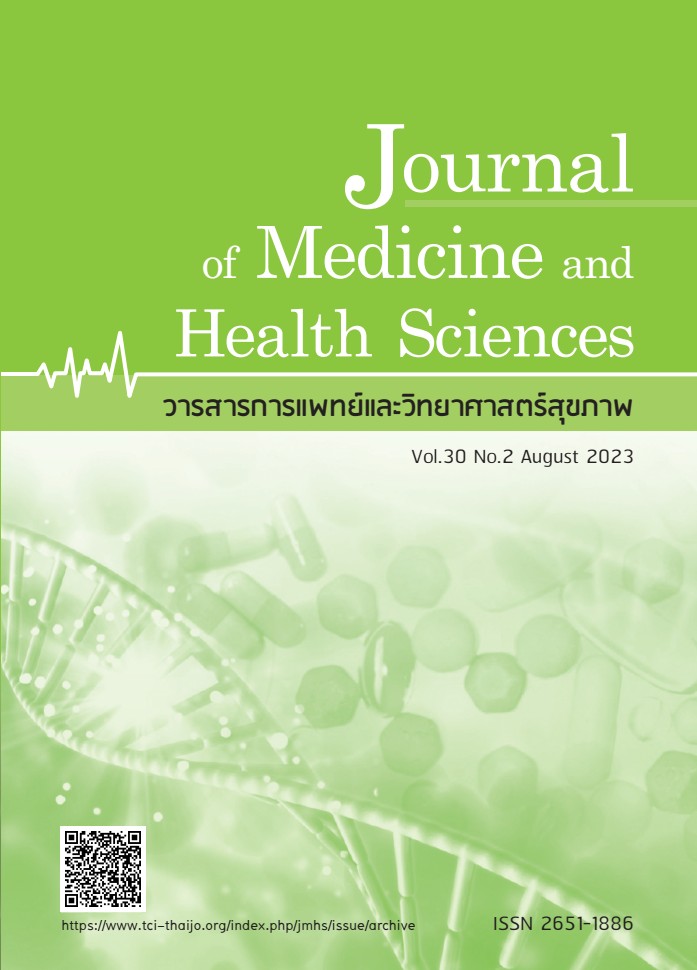Effectiveness of parenteral nutrition order form in neonates
Keywords:
parenteral nutrition, form, prescribing errors, neonateAbstract
Parenteral nutrition (PN) is essential for the growth of pre-term and very low birth weight neonates. However, PN is a risky intravenous feeding procedure with many components. Moreover, PN prescribing requires specific knowledge of the person who prescribes the order. Therefore, there is a high possibility of PN prescribing errors which can affect neonates and working at the Neonatal Intensive Care Unit (NICU) of Panyananthaphikkhu Chonprathan Medical Center (PCMC), there have been many PN prescribing errors. Therefore, This study prepare the PN Order Form with an objective to measure the effectiveness of using the form, which can be measured by the following: 1) PN prescribing errors; 2) day of life that the weight of the neonate returns to birth weight; and 3) abnormal results of laboratory tests before and after the use of the form. The quasi-experimental historical control group study was performed to compare the group before and the group after using the form (control group and intervention group) in a single-center NICU of PCMC from December 2020 to November 2022. It was found that there were 166 orders with errors in 229 orders or 72.5% of the control group. For the intervention group, there were only 15 orders with errors out of 236 orders or 6.4%. The errors in the intervention group were reduced and statistically significant. It was also found that the weight of the neonate returned to birth weight in 11.8 days for the control group, compared with 7.6 days for the intervention group. The weight of the intervention group returned to birth weight statistically and significantly faster. According to the laboratory tests, 17.7% of the control group had hyponatremia and compared to 2.6% of the intervention group. The numbers of hyponatremia observed in the intervention group were statistically and significantly reduced. Therefore, the PN Order Form can statistically and significantly reduce PN prescribing errors, to help the weight of the neonates return to birth weight faster and reduced the hyponatremia of the neonates.
References
Ehrenkranz RA. Early, aggressive nutritional management for very low birth weight infants: what is the evidence? Semin Perinatol 2007;31(2):48-55.
Kraft MD, Tucker AM, Durfee SM, et al. Parenteral nutrition prescribing and order review safety study: The need for pharmacist intervention. Nutr Clin Pract 2021;36(2):480-8.
Mihatsch, W, Shamir R, Goudoever JB, et al. ESPGHAN/ESPEN/ESPR/CSPEN guidelines on pediatric parenteral nutrition: Guideline development process for the updated guidelines. Clinical Nutr 2018;37:2324-36.
Nimitwongsin S, Chansurai S, Buddhanoy A, et al. Outcomes and safety of parenteral nutrition in pediatric patients at King Chulalongkorn Memorial Hospital. Chula Med Bull 2020;2:67-77.
Birch P, Ogden S, Hewson M. A randomised, controlled trial of heparin in total parenteral nutrition to prevent sepsis associated with neonatal long lines: the Heparin in long line total parenteral nutrition (HILLTOP) trial. Arch Dis Child Fetal Neonatal Ed 2010;95:252-7.
Uslu S, Ozdemir H, Comert S, et al. The effect of low-dose heparin on maintaining peripherally inserted percutaneous central venous catheters in neonates. J Perinatol 2010;30(12),794–9.
Ehrenkranz RA, Dusick AM, Vohr BR, et al. Growth in the neonatal intensive care unit influences neurodevelopmental and growth outcomes of extremely low birth weight infants. Pediatrics 2006;117:1253–61.
Hellström A, Hård A-L, Engström E, et al. Early weight gain predicts retinopathy in preterm infants: New, simple, efficient approach to screening. Pediatrics 2009;123:638–45.
Franz AR, Pohlandt F, Bode H, et al. Intrauterine, early neonatal, and postdischarge growth and neurodevelopmental outcome at 5.4 years in extremely preterm infants after intensive neonatal nutritional support. Pediatrics 2009;123:101–9.
Al-Dahhan J, Haycock GB, Nichol B, et al. Sodium homeostasis in term and preterm neonates: III. Effect of salt supplementation. Arch Dis Child 1984;59(10):945–50.
Al-Dahhan J, Jannoun L, Haycock GB. Effect of salt supplementation of newborn premature infants on neurodevelopmental outcome at 10 –13 years of age. Arch Dis Child Fetal Neonatal Ed 2002;86(2):120-3.
Ertl T, Hadzsiev K, Vincze O, et al. Hyponatremia and sensorineural hearing loss in preterm infants. Biol Neonate 2001;79(2):109–12.
Murphy DJ, Hope PL, Johnson A. Neonatal risk factors for cerebral palsy in very preterm babies: case-control study. BMJ 1997;314(7078):404–8.
Li YF, Lu GJ, Han YK. Risk factors for intracranial hemorrhage in very low birth weight infants [in Chinese]. Zhongguo Dang Dai Er Ke Za Zhi 2007;9(4):297–300.
Lehmann CU, Miller MR. Standardization and the practice of medicine. J Perinatol 2004,24:135-6.
Flynn EA, Pearson RE, Barker KN: Observational study of accuracy in compounding i.v.admixtures at five hospitals. Am J Health Syst Pharm 1997;54:904.
Crews J, Rueda-de-Leon E, Remus D, et al. Total Parenteral nutrition standardization and transition to electronic ordering to reduce errors: A multifaceted quality improvement initiative. Pediatr Qual Saf 2018;3:93.
Cynthia L, Nancy A, Alastair A. Error reduction when prescribing neonatal parenteral nutrition. Am J Perinatol 2007;24(7):417-27.
Krzyzaniak N, Bajorek B. Medication safety in neonatal care: a review of medication errors among neonates. Ther Adv Drug Saf 2016;7:102–19.
Chowdary KV, Reddy PN. Parenteral nutrition: Revisited. Indian J Anaesth 2010;54:95–103.
Mackay MW, Cash J, Farr F, et al. Improving pediatric outcomes through intravenous and oral medication standardization. J Pediatr Pharmacol Ther 2009;14:226–35.
Iacobelli S, Bonsante F, Vintéjoux A, et al. Standardized parenteral nutrition in preterm infants: early impact on fluid and electrolyte balance. Neonatology 2010;98:84–90.
Lenclen R, Crauste-Manciet S, Narcy P, et al. Assessment of implementation of a standardized parenteral formulation for early nutritional support of very preterm infants. Eur J Pediatr 2006;165:512–8.
American society for parenteral and Enteral nutrition. ASPEN statement on parenteral nutrition standardization. JPEN J Parenter Enteral Nutr 2007;31:44–8.
American society for parenteral and enteral nutrition (ASPEN) clinical guidelines: Parenteral nutrition ordering, order review, compounding, labelling, and dispensing JPEN. JPEN J Parenter Enteral Nutr 2014;38:334–77.
Downloads
Published
How to Cite
Issue
Section
License

This work is licensed under a Creative Commons Attribution-NonCommercial-NoDerivatives 4.0 International License.



